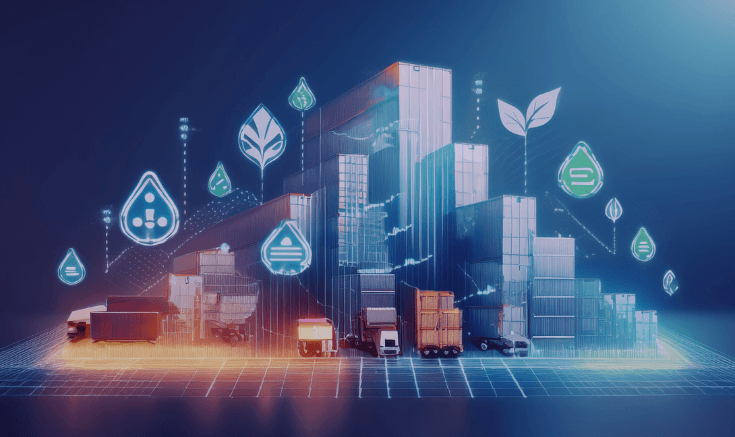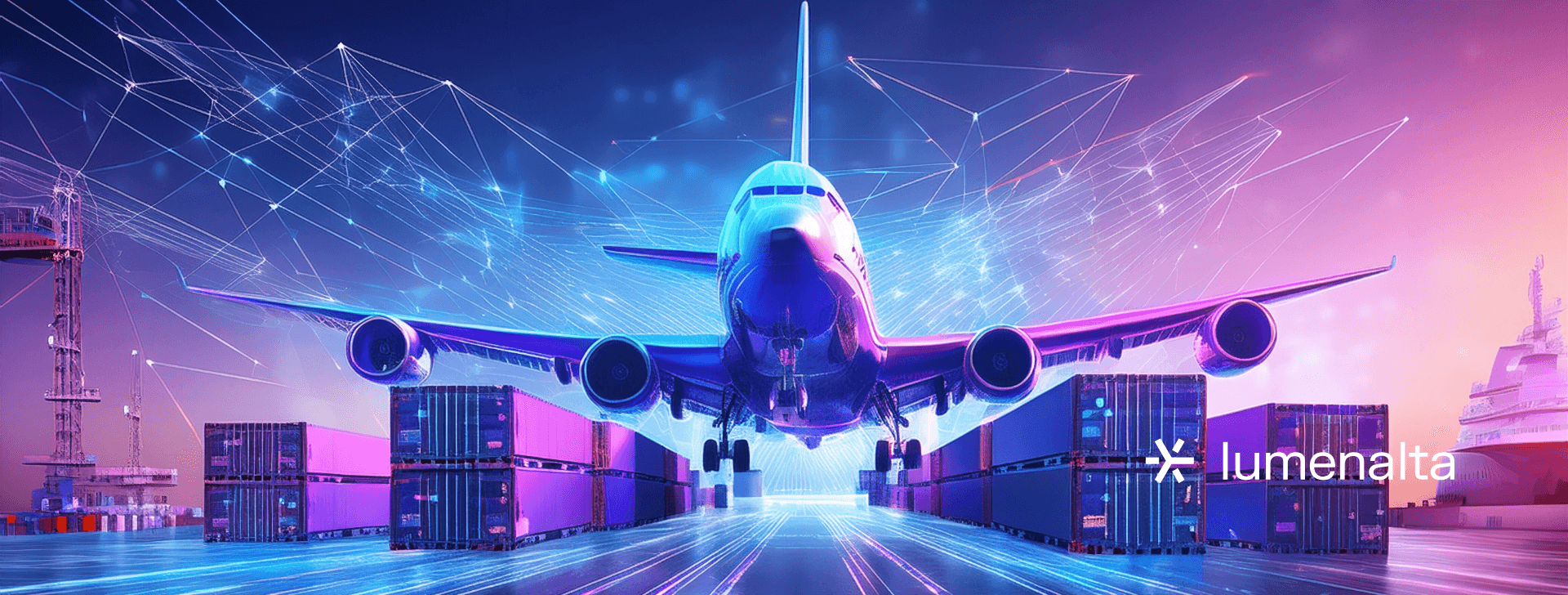

5 types of sustainable freight solutions
MAR. 14, 2025
4 Min Read
Cutting carbon emissions in logistics is achievable through well-planned, sustainable freight solutions.
Many businesses struggle with rising operational costs and growing expectations for greener practices, but there is a clear path forward. Realigning fleets, adopting cleaner fuels, and applying advanced analytics can yield measurable gains in fuel efficiency and profitability. Decision makers who prioritize sustainability often see faster routes to market, better stakeholder alignment, and meaningful ROI.
key-takeaways
- 1. Fuel savings and emissions reductions often go hand in hand with operational efficiency.
- 2. Financial gains come from fewer breakdowns, lower insurance rates, and better asset utilization.
- 3. Sustainable road freight and air freight focus on cleaner fuels, advanced tech, and route optimization.
- 4. Rail and sea freight solutions capitalize on heavy-haul capacity while reducing overall costs.
- 5. Measuring ROI relies on tracking KPIs for fuel use, on-time deliveries, and targeted emission goals.
What is sustainable freight?

Sustainable freight addresses the movement of goods using methods that reduce carbon emissions and promote resource efficiency. It involves strategic process optimization, the adoption of cleaner energy sources, and the reduction of waste across supply chains. These practices enhance reliability and comply with regulations that favor lower emissions. Organizations benefit from the resulting reputation boost and alignment with broader corporate social responsibility priorities.
Stakeholders in logistics see sustainable freight solutions as a powerful strategy to limit negative impacts. This approach makes a tangible difference in operating costs through fuel savings and streamlined logistics. It also ensures organizations stay prepared for policy shifts that support green initiatives. This direction highlights the broader value of consistent improvements in freight operations.
"These practices enhance reliability and comply with regulations that favor lower emissions."
Importance of sustainability in freight transport

Industry leaders recognize that sustainable freight transport brings measurable benefits to public health and reduces strain on natural resources. Lower emissions also contribute to a healthier supply chain by cutting back on pollution and preserving logistical assets. Many decision-makers view these initiatives as a strategic option for brand differentiation. This focus drives deeper engagement with partners who share a commitment to corporate responsibility.
An emphasis on sustainability can also reduce risk by minimizing exposure to volatile fossil fuel markets. Early adopters often access favorable financing or government incentives that support cleaner fleets. A well-structured plan for sustainable freight transport can reduce downtime through better fleet maintenance and reliable technology upgrades. Most importantly, these measures produce a positive impact on profit margins through steady operational efficiencies.
Financial benefits of sustainable freight solutions

Sustainability efforts are not only about ecological impact. They also unlock financial opportunities that streamline workflows and reduce costs. Organizations find value in strategic route planning, better fleet management, and fuel-efficient vehicles. This list highlights some of the direct savings and profitability gains you can expect when adopting sustainable freight solutions.
- Decreased fuel expenses: Improved fleet efficiency reduces overall fuel consumption, creating immediate cost savings and making your operations more predictable.
- Lower maintenance overhead: Clean technologies and well-maintained vehicles are less prone to breakdowns, cutting repair costs and minimizing delays.
- Better insurance rates: Carriers that embrace sustainable practices often qualify for lower coverage premiums, thanks to safer vehicles and reduced emission risks.
- Improved asset utilization: Data-based scheduling prevents idle time and lengthens equipment lifespans, boosting overall fleet performance and asset ROI.
- Attractive partnerships: Many clients now prefer transport providers committed to sustainability, broadening your customer base and improving contract negotiations.
Each of these areas underscores how responsible transport practices have a direct influence on the bottom line. This synergy between cost savings and reduced emissions becomes a long-term investment in business stability. As you optimize processes and manage resources more effectively, your organization benefits from stronger market positioning. These benefits set the stage for exploring even broader methods to expand sustainable freight solutions.
5 types of sustainable freight solutions

1. Sustainable road freight
Reduce your carbon emissions by upgrading fleets to vehicles that rely on low-emission fuels such as biodiesel or electricity. This step lowers overall operating costs when balanced with route optimization software that pinpoints the most direct paths. Consistent maintenance schedules add further value by enhancing vehicle reliability. These improvements help you demonstrate leadership in sustainable freight transport while meeting stringent compliance standards.
Road freight can also integrate advanced telemetry to monitor driver performance, reduce idle time, and deliver prompt feedback for fuel-saving practices. This data-backed insight ensures every trip is as efficient as possible without sacrificing delivery timelines. The end result is a cohesive approach that balances operational performance with ecological responsibilities. Many organizations report double-digit cost savings once these changes scale across an entire vehicle fleet.
2. Sustainable air freight
Capitalize on innovative aircraft technologies that use sustainable aviation fuels and advanced engine designs to curtail emissions. This approach may carry higher initial costs, but it often pays off through greater fuel efficiency and compliance with green regulations. Enhanced cargo loading strategies further optimize weight distribution, decreasing the amount of energy used per flight. Many organizations apply data analytics to schedule flights during optimal weather conditions, reducing fuel burn and maximizing fleet ROI.
Sustainable air freight also benefits from streamlined ground handling processes and well-coordinated logistics support. Standardizing cargo containers and investing in efficient loading equipment can shave minutes off turnaround times. These practices support stronger partnerships with stakeholders who prioritize low-emission shipping. The result is a measurable enhancement in operational resilience and financial performance.
3. Rail freight solutions
Rail transport stands out as a reliable alternative for moving large volumes of goods while reducing carbon emissions. Many companies shift long-distance hauls to rail networks because trains can carry heavier loads with fewer emissions per unit of cargo. This setup stabilizes logistics planning and often proves cost-effective when integrated with last-mile road freight. A well-coordinated approach ensures minimal disruption to delivery times and a smoother flow of goods.
Adapting to rail schedules requires precise coordination, but it also opens doors to volume discounts and reduced congestion fees. Over time, the cost savings add up, supporting reinvestment in more advanced infrastructure. Organizations with rail freight solutions in place often benefit from a more predictable shipping process that fosters better service quality. That stability translates directly into higher profitability and reduced risk for your entire supply chain.
4. Sea freight solutions
Maritime shipping is an essential component of global trade, and optimizing it can make a substantial impact on your sustainability targets. Collaborations with carriers that adopt low-sulfur fuels or liquefied natural gas can decrease harmful emissions. Modern vessels equipped with aerodynamic hull designs further improve fuel efficiency and reduce operational costs. This alignment mitigates compliance risks and broadens your reach in international markets.
Advanced route planning software identifies the most efficient paths, cuts transit time, and trims bunker fuel usage. Seamless communication between ports, vessels, and onshore teams prevents delays and costly rerouting. Sea freight solutions also bring extended capacity, supporting large-scale shipments without multiple smaller trips. This efficiency often translates into better cost control and stronger relationships with overseas partners.
5. Intermodal transport strategies

Combining multiple modes of transport such as road, rail, and sea can reduce bottlenecks and optimize cargo flow. Intermodal coordination cuts down on dwell times by ensuring that each segment of the journey aligns with the next. This integrated setup also decreases handling costs as standardized containers move seamlessly from one vehicle to another. As a result, you gain a flexible system that responds to changing shipping volumes while limiting emissions.
Intermodal transport strategies also create a balanced approach to cost management by distributing shipments across various modes. This method helps you tap into volume discounts, minimize fuel expenses, and make scheduling more predictable. Many businesses find that intermodal freight lowers the total cost of ownership for their transport assets. The payoff is an adaptable framework that meets sustainability objectives and supports long-term growth.
"Many organizations report double-digit cost savings once these changes scale across an entire vehicle fleet."
Measuring the ROI of sustainability in freight
Freight operators track key performance indicators such as fuel consumption, on-time deliveries, and emission reductions to determine effectiveness. Comprehensive analytics platforms convert these data points into actionable insights for more accurate logistics planning. Quantifying results helps justify investments in new technology, fleet upgrades, and training programs. This structure ensures executives see how each initiative ties directly to profits and brand equity.
Another key metric is the payback period for emissions-reduction equipment and training. Many organizations discover that their initial outlay is recovered faster than expected once they tally the benefits of lower fuel bills and efficient route scheduling. Frequent progress reviews guide decision-makers toward the most beneficial tactics without adding unnecessary complexity. Measuring outcomes with precision allows you to adapt and maintain a healthy bottom line.
Sustainable freight solutions are not just a logistical adjustment—they open doors to cost savings, operational efficiency, and a resilient supply chain. Adopting cleaner technologies and optimized transport networks frees you to focus on driving measurable results. At Lumenalta, we create forward-thinking freight strategies that align with your business objectives, equipping you to stay ahead. Let’s chart a brighter path.
table-of-contents
- What is sustainable freight?
- Importance of sustainability in freight transport
- Financial benefits of sustainable freight solutions
- 5 types of sustainable freight solutions
- 1. Sustainable road freight
- 2. Sustainable air freight
- 3. Rail freight solutions
- 4. Sea freight solutions
- 5. Intermodal transport strategies
- Measuring the ROI of sustainability in freight
- Common questions about sustainable freight solutions
Common questions about sustainable freight solutions
What are the top considerations when transitioning to sustainable freight solutions?
How can sustainable freight transport reduce operational costs?
Does sustainable road freight offer quick returns on investment?
What technologies support sustainable air freight?
How do I measure success in implementing sustainable freight solutions?
Want to learn how sustainable freight can bring more transparency and trust to your operations?







